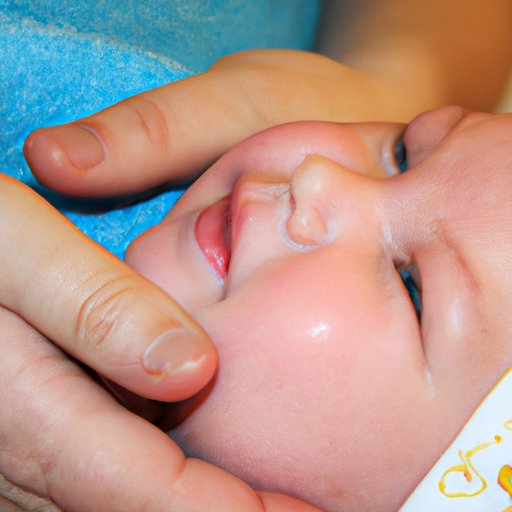
Introduction
Bath-time for newborns is not just essential for maintaining good hygiene, but also for bonding with your baby. Giving your baby their first bath can seem overwhelming, but with the right guidance and safety precautions, it can be an enjoyable experience for both you and your baby. In this article, we will provide a step-by-step guide on how to give your newborn a bath, including safety tips, common issues and troubleshooting, and top tips for bonding in the tub.
Step-by-Step Guide
Setting up a Safe Bath Area
Before you start filling up the tub, make sure you have everything you need within reach, including a clean towel, baby soap, a washcloth, and a diaper. Ideally, you should have a tub specifically designed for babies, or you can use a sink or basin with a non-slip mat.
Selecting the Right Temperature
The ideal water temperature for a newborn’s bath should be between 37 and 38 degrees Celsius. You can use a digital thermometer or simply dip your elbow in the water to test the temperature, ensuring that it’s not too hot or cold.
Washing Your Baby Properly
When it’s time to wash your baby, undress them and carefully lower them into the tub. Use a mild soap and a soft washcloth to gently clean your baby’s body, taking extra care around the face, neck, and diaper area.
Safety Tips
Never leave your baby unattended in the tub, even for a moment. Keep a hand on your baby at all times and avoid using any bath seat or floatation device that can give a false sense of security.
Top Tips for an Effective Bath
Ideal Water Temperature
As mentioned before, maintaining the right water temperature is crucial. The correct temperature will help keep your baby comfortable and relaxed, making bath-time an enjoyable experience.
Right Bath Products
When selecting bath products, make sure to choose mild, fragrance-free, and non-irritating soaps, shampoos, and lotions designed specifically for newborns.
Timing
Newborns don’t need a bath every day, as their skin is delicate and can easily dry out. Aim for two or three baths per week, with sponge baths in between as necessary.
Baby Reflexes
Newborns have a startle reflex that can cause them to flail their arms and legs, so make sure to support your baby’s head and neck at all times during bath-time.
Towel Drying the Skin
After the bath, pat your baby dry with a soft, clean towel, paying extra attention to the folds and creases. Avoid rubbing their skin, as this can irritate their delicate skin and cause discomfort.
Safety First
Highlight the Importance of Safety
Safety should always be your top priority when giving your baby a bath. From the temperature of the water to the type of bath products used, everything should be selected with safety in mind.
Discuss Possible Hazards, Tips for Prevention
Possible hazards during bath-time include slips, drowning, and burns. To prevent slips, use a non-slip mat and support your baby’s head and neck. To prevent drowning, never leave your baby unattended in the tub and don’t rely on any bath seat or floatation device. To prevent burns, always test the water temperature before placing your baby in the tub.
Common Issues & Troubleshooting
Cleaning the Umbilical Cord
To clean the umbilical cord, use a cotton swab dipped in rubbing alcohol, gently wiping the area until it’s clean and dry.
Managing a Fussy Baby during Bath-Time
Babies might get fussier during bath-time, making it more challenging for you to keep them calm. To soothe your baby, try singing, talking, or bathing them in a dimly-lit room.
Maintaining Good Hygiene
To maintain good hygiene, change the water frequently, wash your hands thoroughly before and after bath-time, and launder all the washcloths, towels, and bath toys frequently.
Sharing Bonding Moments
Benefits of Bath-time as a Bonding Activity
Bath-time is not only a crucial part of your baby’s routine, but it’s also an excellent opportunity to bond with your little one. The warm water, gentle touch, and soothing voice can help calm your baby and create a positive association with bath-time.
Tips To Make the Most of Bonding Time in the Tub
To make bath-time a more enjoyable bonding experience, try making eye contact, talking softly, and singing songs with your baby. Playing with bath toys can also be a fun and stimulating way to interact with your little one.
Addressing Concerns & Worries
Common Fears and Worries Related to Giving A Newborn a Bath
Some common concerns parents might have when giving their newborn a bath include the fear of hurting the baby or making mistakes during bath-time.
How to Overcome These Concerns
To overcome these fears, follow the step-by-step guide provided in this article, and take all the necessary safety precautions. Remember that it’s normal to make mistakes, and with time and practice, you’ll become more confident and comfortable giving your baby a bath.
Conclusion
Giving your newborn a bath can be an enjoyable and relaxing experience for both you and your baby. By following these simple guidelines and taking the necessary safety precautions, you can ensure that your little one’s bath-time is positive, hygienic, and bonding.




